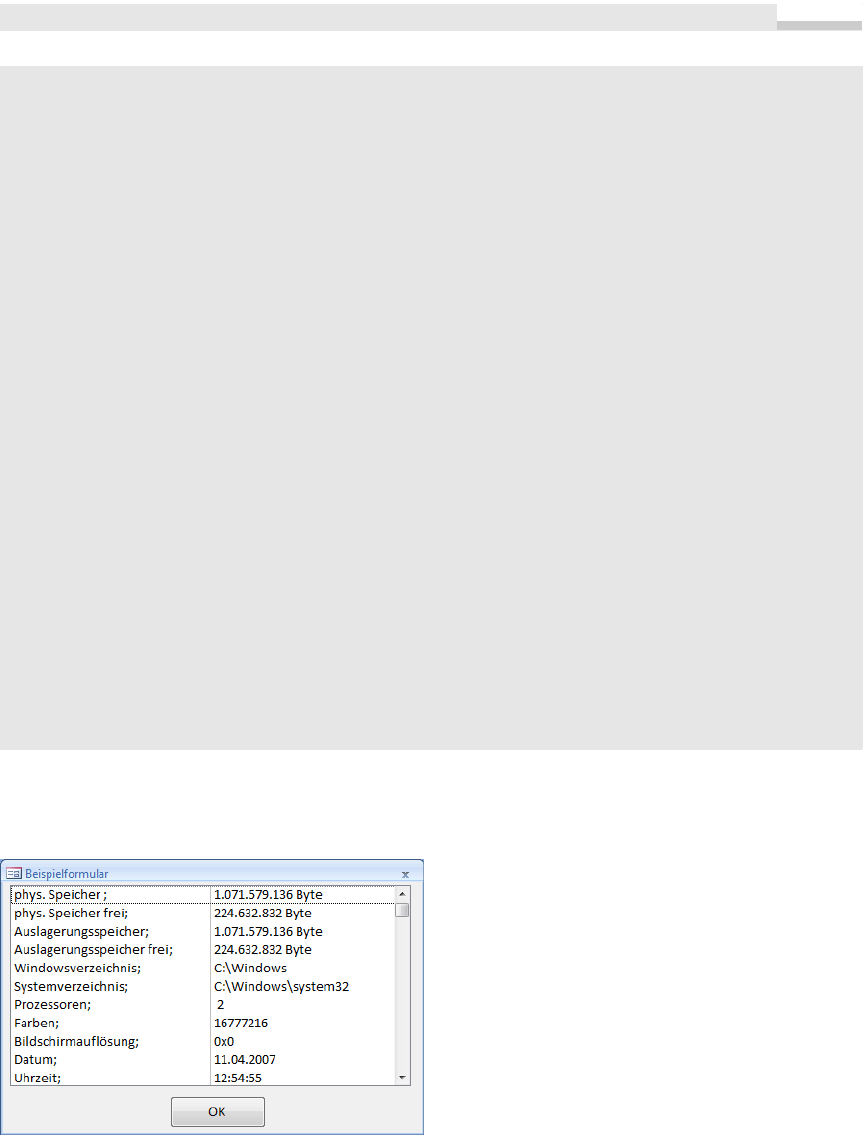
Informationen über das aktuelle System ermitteln
API-Programmierung; GetWindowsDirectory-, GetSystemDirectory-, GlobalMemoryStatus-, GetDeviceCaps-,
GetSystemInfo-Funktion;
Um etwas über das System zu erfahren, müssen wir schon die API bemühen. Unter den vielen abrufbaren
Informationen sind für uns im Wesentlichen die folgenden Angaben interessant:
■ Arbeitsspeicher und freier Arbeitsspeicher
■ Auslagerungsdatei
■ die Systemressourcen (GDI, USER)
■ das Windows-Verzeichnis und das System-Verzeichnis
■ die Prozessoranzahl
■ die Bildschirmauflösung
■ Datum und Uhrzeit
Oberfläche
Unser Formular bestücken wir mit einem Listenfeld für die Anzeige der Parameter sowie einer Befehlsschalt-
fläche zum Beenden des Programms.
API-Programmierung
Der Aufwand zur Ermittlung von Systeminformationen in einer 32-Bit-Systemumgebung ist etwas höher
als bisher gewohnt, dafür lassen sich aber auch mehr Informationen abrufen.
Binden Sie zunächst die folgenden Typen/Konstanten und API-Funktionen in das Projekt ein:
Type MEMORYSTATUS
dwLength As Long
dwMemoryLoad As Long
dwTotalPhys As Long
dwAvailPhys As Long
dwTotalPageFile As Long
dwAvailPageFile As Long
dwTotalVirtual As Long
dwAvailVirtual As Long
End Type
Global memory As MEMORYSTATUS
Declare Sub GlobalMemoryStatus Lib "kernel32" (lpBuffer As _ MEMORYSTATUS)
Declare Function GetWindowsDirectory Lib "kernel32" Alias "GetWindowsDirectoryA" _
(ByVal lpBuffer As String, ByVal nSize As Long) As Long
Declare Function GetSystemDirectory Lib "kernel32" Alias "GetSystemDirectoryA" _
(ByVal lpBuffer As String, ByVal nSize As Long) As Long
Type SYSTEM_INFO
dwOemID As Long
875
Praxisbeispiele

HINWEIS
Kapitel 13: Programmschnittstellen
dwPageSize As Long
lpMinimumApplicationAddress As Long
lpMaximumApplicationAddress As Long
dwActiveProcessorMask As Long
dwNumberOfProcessors As Long
dwProcessorType As Long
dwAllocationGranularity As Long
dwReserved As Long
End Type
Global systeminfo As SYSTEM_INFO
Declare Sub GetSystemInfo Lib "kernel32" (lpSystemInfo As SYSTEM_INFO)
Declare Function CreateDC Lib "gdi32" Alias "CreateDCA" _
(ByVal lpDriverName As String, ByVal lpDeviceName As Any, _
ByVal lpOutput As Any, ByVal lpInitData As Any) As Long
Public Const SIZEPALETTE = 104
Declare Function GetDeviceCaps Lib "gdi32" (ByVal hdc As Long, ByVal nIndex As Long) As Long
Declare Function DeleteDC Lib "gdi32" (ByVal hdc As Long) As Long
Die Funktions-Aufrufe
Dim Puffer As String * 255
Dim i As Integer, zw As String, dWords As Long
Dim dc As Long, ta As String
Dim BitPix As Long
ta = ";"""
Initialisieren Sie den Parameter dwLength mit der Größe der Struktur. Der Grund liegt in der späteren
Erweiterbarkeit (zusätzliche Systeminformationen).
memory.dwLength = Len(memory)
Speicherinformationen gewinnen:
GlobalMemoryStatus memory
additem "phys. Speicher " & ta & Format(memory.dwTotalPhys, _
"###,###,###,###,###,###") & " Byte"
additem "phys. Speicher frei" & ta & Format(memory.dwAvailPhys, _
"###,###,###,###,###,###") & " Byte"
additem "Auslagerungsspeicher" & ta & Format(memory.dwTotalPhys, _
"###,###,###,###,###,###") & " Byte"
additem "Auslagerungsspeicher frei" & ta _
& Format(memory.dwAvailPhys, "###,###,###,###,###,###") & " Byte"
Windowsverzeichnis bestimmen:
Puffer = Space$(255)
i = GetWindowsDirectory(Puffer, 255)
addItem "Windowsverzeichnis" & ta & Left(Puffer, i)
876

Systemverzeichnis bestimmen:
Puffer = Space$(255)
i = GetSystemDirectory(Puffer, 255)
addItem "Systemverzeichnis" & ta & Left$(Puffer, i)
Prozessoranzahl bestimmen:
GetSystemInfo systeminfo
addItem "Prozessoren" & ta & Str(systeminfo.dwNumberOfProcessors)
Die Farbauflösung und die Bildschirmauflösung erhalten wir über einen Gerätekontext:
dc = GetDC(0)
BitPix = GetDeviceCaps(dc, 12)
If BitPix > 24 Then BitPix = 24
additem "Farben" & ta & CStr(GetDeviceCaps(dc, 14) * 2 ^ BitPix)
ReleaseDC 0, dc
addItem "Bildschirmauflösung" & ta & CStr(GetDeviceCaps(dc, 8)) & "x" & CStr(GetDeviceCaps(dc, 10))
DeleteDC dc
Datum und Uhrzeit:
addItem "Datum" & ta & CStr(Date)
addItem "Uhrzeit" & ta & CStr(Time)
Eine Hilfsfunktion für die Anzeige:
Sub additem(s As String)
If list1.RowSource <> "" Then
list1.RowSource = list1.RowSource & ";""" & s & """"
Else
list1.RowSource = list1.RowSource & """" & s & """"
End If
End Sub
Test
Nach dem Start dürften bereits alle Informationen angezeigt werden:
Abbildung 13.33 Die abgefragten Systeminformationen
877
Praxisbeispiele
Get Microsoft Office Access 2007-Programmierung - Das Handbuch now with the O’Reilly learning platform.
O’Reilly members experience books, live events, courses curated by job role, and more from O’Reilly and nearly 200 top publishers.

